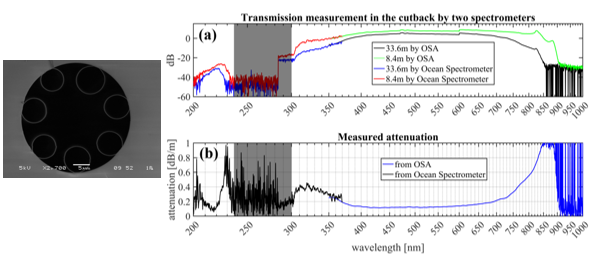Synthetic fused silica has been widely used as an optical fiber material for its high transparency in the visible and near-IR spectral range as well as its mechanical robustness, high chemical resistance and good biomedical compatibility. Silica-based optical fibers are the mainstay of optical telecommunications and many other applications. The development of soft glass materials with reduced phonon absorption at mid-infrared wavelengths has broadly extended the spectral range of optical fibers at long wavelengths. Unfortunately, at ultraviolet wavelengths no alternative glasses other than silica glass have been identified and silica fibers continue to exhibit high attenuation as well as fluorescence and photodarkening. Multiphoton absorption and optically-induced color center formation are primary causes of the poor performance of silica-based fibers in the UV, along with increasing material absorption and Rayleigh scattering. The formation of color centers is associated with photodarkening and this is referred to as solarization which ultimately limits the laser delivery in silica fibers at UV wavelengths.
Laser Focus World in May reported the latest breakthrough of low-loss single-mode solarisation-resistant hollow-core fiber for high-power laser transmission at ultraviolet wavelengths. A team led by Dr. Yu Fei from Shanghai Institute of Optics and Fine Mechanics, Chinese Academy of Sciences, found that the anti-resonant hollow-core fiber had the transmission windows covering the whole UVA and part of UVC spectral ranges and achieved the minimum attenuation of 0.1 dB/m at 218 nm, less than the intrinsic material absorption of fused silica glass at this wavelength by nearly one order of magnitude. Solarization-free transmission was also demonstrated in another similar anti-resonant hollow-core fiber at 226 nm by delivery of 17 nanosecond 0.46 μJ laser pulses at 30 kHz repetition rate.
In hollow-core fiber light is confined in an air/vacuum core rather than in solid silica. Unlike index guiding solid fibers, anti-resonant hollow-core fiber realizes light transmission by strong reflection from cladding of complex structure. Anti-resonant hollow-core fibers are featured by multiple broad spectral transmission windows, low attenuations, good single-modeness. Due to the reduced modal overlap with fiber material down to 10-4-10-5, anti-resonant hollow-core fibers usually exhibit high damage laser power threshold, solarisation-free, radiation resistance, as well as low material absorption, low optical nonlinearity and low modal dispersion, which make anti-resonant hollow-core fibers ideal candidates for high-power laser for various applications.
The work, entitled “Hollow-core fibers deliver ultraviolet light without solar degradation” was published in Laser Focus World on April 16, 2018.
Article Website:
https://www.osapublishing.org/oe/abstract.cfm?URI=oe-26-8-10879

Fig. Anti-resonant hollow-core fiber and its measured attenuations
Contact:
Mr. Cao Yong
General Administrative Office
Shanghai Institute of Optics and Fine Mechanics, CAS
Email: caoyong@siom.ac.cn